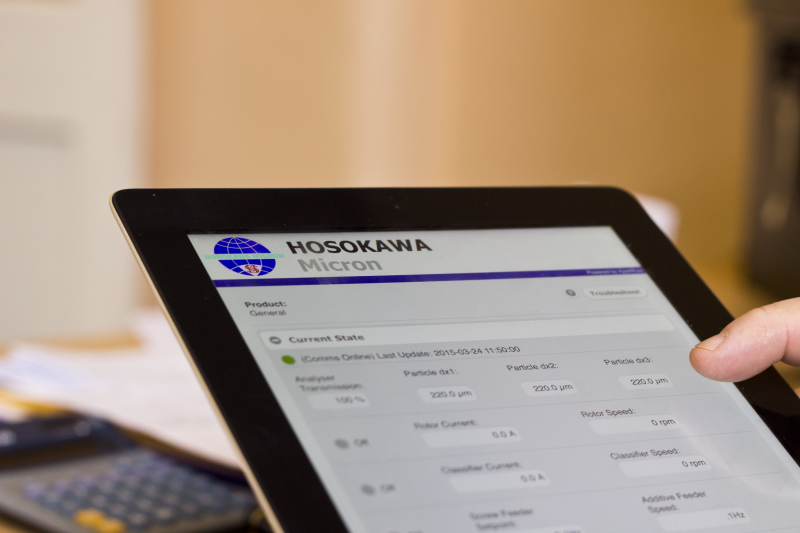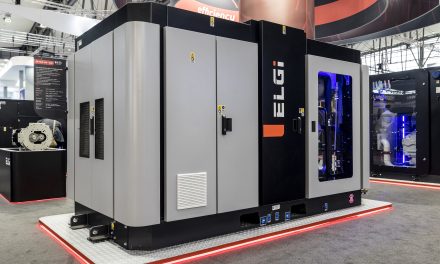 Hosokawa Micron’s Remote Monitoring Solution was retrofitted to an ACM, Air Classifier Mill, part of a powder milling plant with processing steps controlling the feed-rate of raw material and additives, mechanical grinding and classification then filtering of the exhaust air and bagging of product materials – providing a practical insight into the Hosokawa Micron monitoring system’s functionality, benefits, market advantages and potential for getting the best from existing plant and equipment.
Hosokawa Micron’s Remote Monitoring Solution was retrofitted to an ACM, Air Classifier Mill, part of a powder milling plant with processing steps controlling the feed-rate of raw material and additives, mechanical grinding and classification then filtering of the exhaust air and bagging of product materials – providing a practical insight into the Hosokawa Micron monitoring system’s functionality, benefits, market advantages and potential for getting the best from existing plant and equipment.
Condition monitoring for preventative maintenance is a popular use of remote monitoring but the Remote Monitoring Solution from Hosokawa delivers much more – including on-line diagnostics for improved plant availability, analytics designed for improving product quality and remedial workflow instructions that can minimise downtime.
Measurements connected to the data logging module included the status, speeds and current for each of the electric motor drives and the system air flow and pressure measurements. These were supplemented by two additional sets of measurements from the milling plant. Firstly measurements of vibration and temperature were added to the main bearing housing of the mill to help provide an assessment of condition of the bearings and secondly an online particle size analyser using laser diffraction technology was fitted to the product line to provide a continuous measurement of the D10, D50 and D90 particle sizes. All the measured values were uploaded to the Cloud every 2 minutes via the GSM connection of the data logger.
Figure 2 shows an example user interface display from the milling facility which runs as a native app on most common mobile devices. Both live values and historical trends of data can be accessed. Condition based alerts are sent to users in the event of a pattern in the incoming data indicating either a developing problem or an abnormal operating issue. The alerts take into account the operating conditions on the mill and the duration of time they are active before being sent. Predictive Analytics are used to provide an estimate of the expected values of key variables such as vibration levels and drive currents for different products and grades.
Remote Monitoring Benefits
The expected benefits of installing the system at the production site, combined with remote technical support provided by Hosokawa equipment experts are:
Reduction in unplanned shutdowns
An example of how a problem developing in the main mill rotor drive bearing can be detected by remotely monitoring the vibration level of the bearing housing is shown in Figure 3. An unexpected increase in the level of vibration occurred 9 days before high vibration and noise levels resulted in the mill being taken out of service. Inspection indicated high bearing wear. Early warning of mechanical failure allows operations to schedule plant maintenance with minimal disruption and also minimises off spec product due to incorrect machine operation.
Fewer Site Visits
Site visits to inspect the condition of equipment scheduled at regular time periods do not necessarily reflect the actual level of use. Remote monitoring allows these factors to be continually monitored so that maintenance visits are made only when warranted.
Our experience with remote monitoring on the processing plant is that many problems can be diagnosed remotely by detailed analysis of the trends of key measurements in conjunction with input from end users at the site. To assist end users in diagnosing problems a knowledge base of common problems and the relevant checks to determine their root cause has been developed. Remote monitoring can potentially shorten the time to rectify problems by days or weeks compared to the time it may take to get qualified personnel to a remote site.
Improved Equipment Performance
Remote monitoring can also be used to highlight where there is an opportunity to improve performance such as minimising energy consumption and/or increased throughput. For example the analyser on the milling plant for measuring particle size distribution allows an advisory notification to be generated when a significant level of overgrinding is taking place in the mill. Similarly where there is an objective to maximise production an advisory notification can be issued to the end user if there is spare rotor load capacity or if air flow rate should be increased.
Increased visibility of operations
Previously operating information was only available via a manual shift log now there is the benefit of increased visibility of the operational performance of both the plant staff and the staff working away from site or available on standby. As well as the displays of live values, trends and alerts a report summarising key production indicators for the previous day is automatically emailed to all site management. The report tracks running hours, active diagnostic warnings and average values for measurements during the course of the previous 24 hours of operation. The daily production report has resulted in improvements in scheduling of production runs particularly around shift changeovers and provides a record of the machine performance and settings for each batch production run.
For manufacturing companies cautious about allowing any external access to their site based automation and control systems it is worth confirming that Hosokawa Micron’s Remote Monitoring system is kept completely separate from any existing control systems. The type of data accessible to different users, such as which measurement values can be viewed and over what time period, can be restricted in order to maintain the privacy of sensitive data.


